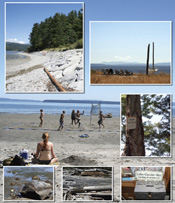>> This entire issue is available as a 12MB PDF download
Table of Contents
The “Raggeds”: Magical islands on route to Desolation
Mini-golf and ice cream: An unbeatable combination
Are you a local?
Living Green: Eating Local
Family Matters: Everything Counts
For Art's Sake: Art Shows in August
Savouring Savary: Day trippin’ in an island paradise
Lund Water Taxi: Transporting people, and their stuff
A tale of tragedy and heroism: The wreck of the MV Gulf Stream
Powell River wrestler to Olympics Representing Australia
Explore Powell River
The “Raggeds”
Magical islands on route to Desolation
By Ian Hobbs
The Ragged Islands (also known as the Copeland Islands) are a virtually unknown gem on the upper Sunshine Coast. If you have not taken a trip out to experience them, add it to the top of your ‘To Do’ list. All summer long we watch the boats stream by the Ragged Islands heading for Desolation Sound and all summer long we get phone call after phone call looking for boat trips to see the world famous Desolation Sound Marine Park. Don’t get me wrong, a trip to Desolation Sound to experience the majesty of the towering peaks, the rugged cliff faces and water that is over 2,100 feet deep is well worth your time but in my books the Ragged Islands is a spot so magical that every trip back holds new wonders. Given that I do over 400 hours of boat tours a year and that I have probably snorkelled and dived in the park more than 100 times, that is no small statement.
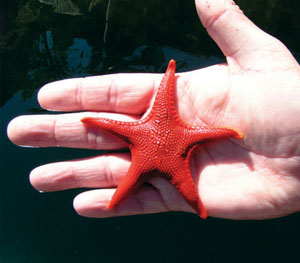 The Raggeds are teeming with life, both above and below the water, predominantly driven by the fact that they are surrounded by some of the warmest ocean water in Canada. The water in the park reaches an astonishing 22-24 degrees Celsius in the summer time, which is just a bit of a difference from the 7-10 degrees that you can expect in places like Victoria and Tofino. I know where I’d rather go swimming! The reason the water is so warm is that the tides flooding around both ends of Vancouver Island meet just north of the park, meaning that the water in this area just sort of sloshes back and forth rather than getting flushed out and cooled. This warm, clean water makes for an abundance of life below the water which in turn supports a great deal of life above the water.
The Raggeds are teeming with life, both above and below the water, predominantly driven by the fact that they are surrounded by some of the warmest ocean water in Canada. The water in the park reaches an astonishing 22-24 degrees Celsius in the summer time, which is just a bit of a difference from the 7-10 degrees that you can expect in places like Victoria and Tofino. I know where I’d rather go swimming! The reason the water is so warm is that the tides flooding around both ends of Vancouver Island meet just north of the park, meaning that the water in this area just sort of sloshes back and forth rather than getting flushed out and cooled. This warm, clean water makes for an abundance of life below the water which in turn supports a great deal of life above the water.
The best time to visit the Raggeds is on a low tide. With an 18-foot tide swing the park looks dramatically different at high tide and at low tide. At low tide you can expect to see literally thousands of multi-coloured ochre stars clinging to the cliff faces above the water line. Peering into the water with polarized sun glasses it’s common to see giant sunflower stars up to three feet across the arms, morning glory sun stars, northern striped sun stars, leather stars, painted stars, vermillion stars, blood stars and cushion stars to name a few. At low tide all the stars get compressed just below the surface of the water so you can typically see a number of varieties from the surface usually seen only by snorkellers and divers. It’s not all just about the sea stars as below the water the park teems with over a dozen varieties of crabs, giant red and green urchins, sea cucumbers, rock scallops, octopus, wolf eels, encrusting sponges and tube anemones. Above the water it’s birds, seals and oysters. During the summer months there are lots of different types of gulls, eagles and eagle nests, guillemots, murrelets, oyster catchers, grebes, cormorants, pipers and plovers. It is easy to spend hours exploring the shorelines and tide pools finding new and interesting life forms.
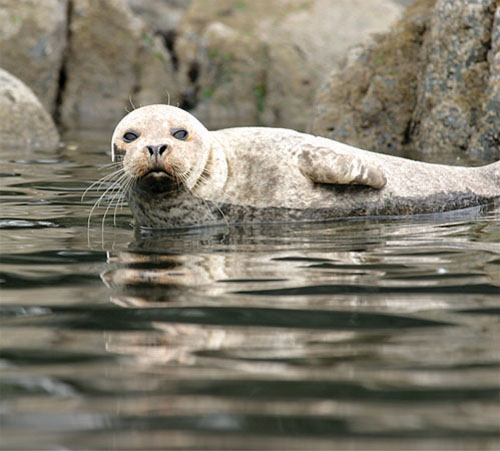
Another reason this little park is one of my favourites is that there are so many different ways to enjoy it. Boating, kayaking, snorkelling and scuba diving are all available options out of Lund. Both ourselves and Terracentric Adventures run small boat tours into the park, which let you get up close and personal with the wildlife. The Swan Spirit, Pristine Charters and Beyond the Road Adventures run bigger boat tours. Rockfish Kayak has both rental kayaks and guided tours to the park and Alpha Dive would be happy to show you the 120-foot wreck in the park and take you on a critter-crawl.
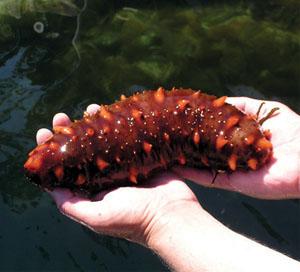 The final reason I love this park is that it is ever changing. Season to season there are new and exciting things to see. During the winter the park has Caribbean level visibility of 100 plus feet so the diving in the winter is amazing. The water temperature in the winter is a chilly 6 degrees so the best times for snorkelling are in the spring and fall as the water is warm(ish) and the visibility is still good. We find any temperature over 11 degrees is comfortable in a 5mm wet suit and at that time you can still expect 30-50 foot visibility. The best time for birding in the park is the fall, winter and spring when the park becomes a major migratory resting spot and wintering ground. You can expect to see flocks of hundreds of harlequins, mergansers, goldeneyes, buffleheads, scoters and ruddy ducks.
The final reason I love this park is that it is ever changing. Season to season there are new and exciting things to see. During the winter the park has Caribbean level visibility of 100 plus feet so the diving in the winter is amazing. The water temperature in the winter is a chilly 6 degrees so the best times for snorkelling are in the spring and fall as the water is warm(ish) and the visibility is still good. We find any temperature over 11 degrees is comfortable in a 5mm wet suit and at that time you can still expect 30-50 foot visibility. The best time for birding in the park is the fall, winter and spring when the park becomes a major migratory resting spot and wintering ground. You can expect to see flocks of hundreds of harlequins, mergansers, goldeneyes, buffleheads, scoters and ruddy ducks.
Well it’s the busy season and I have to go do another boat tour. Hopefully these words and photos will motivate you to go out and explore one of the wonders of your own back yard!
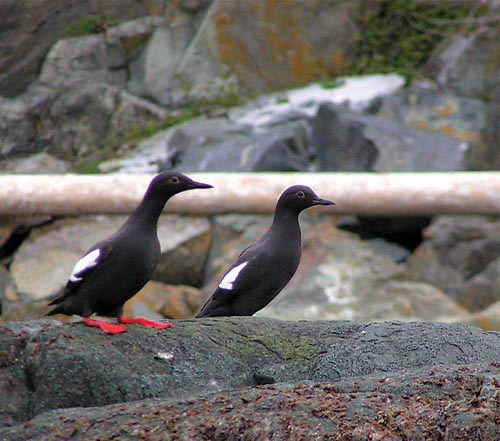
Mini-golf and ice cream
An unbeatable combination
By Hailey Sacree
Go ahead, try to drive past Putter’s Mini-golf without begging your parents to stop. I find it almost impossible to resist looking up. Watching the cool blue fountains spraying from the ponds, seeing the kids swinging their golf clubs in an attempt to show their friends how good they are. I think back to the ice cream… all those delicious flavours… so hard to choose! As our car goes speeding past I often wish I was there, instead of driving to wherever I’m going.
One lucky day my friend Kolten and I went after school. It was the last week of school and kind of cloudy but that didn’t matter. We chose the colors of our balls and then started on the first hole. I must say, the person who designed Putters is super creative in the decorations and the course. There are little buildings, statues, flowers, and even waterfalls and bridges. The set up for all the different holes is really cool. Some of them are downhill, others you have to bump your ball up to get it in. I find it gets harder and harder and harder as you get farther into the game. I can’t believe how great it feels when you get a hole in one or how frustrating it is when the ball rolls back down the hill.
I think my favourite hole is the one with the lighthouse. Although I have never gotten it in in one go, I always run up and plunk it in the hole anyways. I find that if you do that it will roll down the tunnel and into the second hole without a doubt. If you do manage, I believe you get a free round, so try your luck.
Last time I played, there were some people ahead of us and we were waiting by one of the pools and a frog came out of it. I didn’t think it was real but the girls ahead of us poked at it with their club and it jumped back in again. (I thought it was a statue.) If I had known what it was I would have definitely tried to pick it up!
When we finished our game, we ran into the building and picked out the most delicious ice cream I have ever had, mint moose tracks. It was divine! They have so many flavors and I like to have a gumball put in the bottom of the cone. The only problem with that is by the time you have eaten your ice cream your gumball is as hard as rock and almost breaks your teeth!
It is so fun to go mini golfing in Powell River. I have been there for countless birthday parties and day trips. Check it out—you won’t be bored. It is a perfect way to spend a sunny day.
Are you a local?
By Margaret Page
“Are you a local?” Have you ever been asked that question? What does it mean? How do we define “a local”?
As it turns out, the answer depends on who you ask.
Once, shortly after moving to the Sunshine Coast, I asked an older gentleman, “How many years do you have to be here to be considered a local?” He answered, “Thirty years.”
“Wow!” I gasped. “That means I will be 80 years old before I am considered a local!” I couldn’t help but think of all the taxes I would have paid by then, and all the time, talent and treasures I would have donated to local charities and organizations by then. Another gasp!
Sometime later I asked another lifelong resident, “How long do you think it will be before I am considered a local?” She pondered the question. “I think it takes five years for someone to fully transition from wherever they lived prior to moving here. By then, you’ve decompressed and learned the local ways.”
When I lived in Las Vegas, the standard seemed to be a year. By then, people had figured out whether they were visiting or staying. But then again, Vegas is a fast town.
I found it interesting that no matter where I was or who I asked, people measured your “local status” in hard time. Yet in my mind, hard measures of time only seem valid in aging and prison… both dreadful analogies.
Perhaps we could consider a softer measure than time. Maybe we could say something like…
You might be a local if you’ve:
- Helped a neighbour through a difficult time.
- Thrown a party and all your guests lived within 20 km.
- Racked up any library fines.
- Recognized a name in the “Letters to the Editor”, obituary pages, or social announcements.
- Noticed the patterns and habits of the local birds and wildlife (or at least your neighbours).
- Developed a preference for (or aversion to) a certain clerk at the nearest grocery store.
- Taken more than five minutes to pick up one item at the grocery store because of the acquaintances you’ve encounter while there.
- Learned how to avoid ferry traffic.
- Stumbled upon hidden picnic spots, rope swings and “Lovers’ Lane”.
- Savoured the sun setting over a familiar landscape, or the sunrise with a warm cup in hand and slippers on your feet, and felt a deep sense of home in your heart.
After all, isn’t that what it really means to be a local—to call this home and really feel it deep inside?
Yep… I’m a local.

Eating Local
by Emma Levez Larocque
Do you know where your food comes from? That’s a question an increasing number of people are asking these days. As a society we have become detached from the food we put in our mouths, and it has created problems—obesity, disease and malnutrition among them.
Several years ago this disconnect started a movement that encouraged us to look to the past, to a time when food came from the farms and gardens around us—to a time when we knew exactly where our food came from because we grew it ourselves, and traded it with our neighbours.
In 2005 Vancouverites James MacKinnon and Alisa Smith started a grassroots challenge called the 100-Mile Diet. For a year they vowed to eat only foods that had been grown and produced within a 100-mile radius of where they lived. This challenge started a wave—one that caught on in Powell River in the form of the 50-Mile Diet three summers ago. Since that time, the number of participants has doubled—from 253 in the first year to more than 500 this summer. Lyn Adamson, who started the challenge locally, says people take part for a number of different reasons.
“Most people,” she says, “like to have a connection to their food source. It is about being part of a community and belonging to your community when you are purchasing food from your neighbours. I think a number of people want to live more sustainably, and are worried about the effects of carbon pollution to deliver food products. Many feel local food is fresher and healthier—not corporately grown with an abundance of pesticides and herbicides.”
Fran and Simon Cudworth own Periwinkle Granary, a small business that provides Powell Riverites with freshly milled, organic grains such as rye, spelt, oats and a variety of flours.
“There has definitely been a change in awareness,” Fran says. “This is our third season at the Open Air Market, and our customer base has grown every year. A lot of people are interested in growing their own grains, and we get more and more questions about our grains and the milling process. There has always been a group of people who have been aware and interested in local, organic foods, but there is now a whole new group of people starting to think about it—and many of those people are young families, people thinking about what they are feeding their kids.” There are no chemicals or preservatives in the grains the Cudworths sell; they should be used within 72 hours of purchase.
The importance of buying food fresh means that people shop more frequently, and this has precipitated another change, Simon explains. “People are starting to look at how they shop—it’s a different experience they are looking for. They want to see the face of the person behind the food they are buying.”
People are not only looking to buy more local food, but to producing more of it themselves. Judi Tyabji Wilson and Gordon Wilson bought a small farm south of Powell River about four years ago. Their long-term goal is to be as self-sufficient in their food sources as they can be. They raise sheep and chickens, have planted a variety of apple trees, and have plans for a big vegetable garden in the near future.
“We have both watched BC farm land disappearing at an alarming rate while the food on local shelves is increasingly produced in unregulated environments in other countries,” Judi says. “This has made us quite worried about food security and supply and we don’t trust that what we’re buying at the grocery store is safe, or that we’ll have the same kind of supply or affordability in five years. Additionally, we love animals, and we want to know that the meat we eat has come from animals that have had a good life and that the eggs are fresh. Factory farming should be illegal—we’re trying to opt out of that market as much as possible.”
Eating food that has been grown and produced so close to home is not always an easy task. Thanks to international trade, we have become accustomed to having year-round access to every imaginable kind of food. But if you are dedicated to eating local foods, that variety is impossible to replicate—especially outside of summer months. In essence, that is the idea behind the movement—to eat seasonally, and to be more in tune with the rhythms of the world around us. It encourages people to be more aware of where their food is coming from, and the real costs of getting it there. According to the article “100-Mile Diet: No Piece of Cake” in the May 2008 issue of Okanagan Life magazine, the average Canadian meal travels 2,500 kilometres to reach the dinner table.
While eating completely locally is not easy, becoming part of a group like the 50-Mile Diet can help. People who register will have the opportunity to share information with others about local food sources, share recipes that emphasize local ingredients and have fun sourcing out local food. Register by calling Lyn at 604-414-0990 or email fsp@prepsociety.org (fsp for ‘food security project’).
Ten reasons to buy local food
Source: www.growingformarket.com
- It simply tastes better (it’s fresh and full of flavour).
- Local produce is better for you (when food is fresh it contains more nutrients).
- Local food preserves genetic diversity (when food does not have to be tough enough to survive transportation from distant places, a wider selection of varieties can be grown).
- Local food is GMO free (local farmers don’t have access to genetically modified seed, and most of them wouldn’t use it if they could).
- Local food supports local farm families (local farmers who sell direct to consumers cut out the middleman and get full retail price for their food).
- Local food builds community (re-establishing a time-honoured connection between the eater and the grower).
- Local food preserves open space (as the value of direct-marketed fruits and vegetables increases, selling farmland for development becomes less likely).
- Local food keeps your taxes in check (farms contribute more in taxes than they require in services).
- Local food supports a clean environment and benefits wildlife (a well-managed family farm promotes fertile soil, clean water, nutrient replacement and erosion prevention, and it provides a perfect environment for many wildlife species).
- Local food is about the future (by supporting local farmers today you can help ensure future generations access to nourishing, flavourful and abundant food).

Everything Counts
By Isabelle Southcott
Every single thing you do in life matters and everything counts.
Holding open the door for someone, smiling, sharing a chuckle, buying a friend a cup of coffee, paying a sincere compliment, or spending time with a friend.
All of these seemingly little things are important in the big scheme of things. In fact, they are just as important as the BIG things although you may not think so at the time.
Life is all about building. We start with one block, idea, thought, word or deed and add to them. Whether you are training for a marathon, studying for an exam, raising a child, or running a business, everything single thing you do counts.
I recently attended a magazine publishing workshop and one of the speakers talked about this concept. During her presentation, she told us that everything you do in business counts. I thought about what she said and realized that everything you do in life counts.
Not long ago we spent part of our summer holidays in Mukilteo, Washington State. We ate dinner one night at a seafood restaurant by the name of Ivar’s. Our server for the evening was Melanie. Now I usually don’t remember the names of all the servers I encounter but this one was unforgettable and here’s why.
My brother-in-law ordered steak, medium rare, to go with his seafood. His steak was nice but it was medium well and although he commented on it to us, he said it wasn’t a big deal because Melanie had recommended an excellent wine and everyone else’s meal was top notch. Melanie also checked in with us several times to see how we were making out and was friendly and genuinely attentive. On one of those stops by our table Melanie noticed that my brother-in-law’s steak was medium well rather than medium rare! She apologized profusely for the mistake and then left. A few minutes later she returned and said she’d talked to the kitchen and would like to offer him a complimentary dessert in order to make up for this mistake. She suggested the strawberry shortcake as it was delicious and large enough to share. Melanie was right.
We began chatting and she asked if we were from Canada. We said yes and she said she grew up in Edmonton, the same city my sister lived in for 10 years. Then she asked us about our travel plans and made some excellent suggestions that she thought my boys would enjoy.
That dinner will long be remembered by all of us because our server, Melanie, made it memorable. She wasn’t just serving a meal, she wanted to make sure we enjoyed our entire evening. Everything she did that night from greeting us with a welcoming smile, to suggesting a great wine to helping us choose our meals, all added up to make a great evening. Individually these things seem insignificant but together they make up something much bigger.
If everything you do in life counts, you need to make sure you are always doing the right thing and if you find you aren’t you need to change. You need to make sure that what you say or what you do is what you mean. This is your life, there are no second chances. It is up to each and every one of us to live our best life because everything counts.

Art shows in August
by Jessica Colasanto
If your notion of an art show is a stuffy, dark museum—or even a stuffy, pretentious gallery—then you haven’t experienced an August art show in Powell River!
Many people comment that they can better understand and appreciate art after talking with an artist and seeing the creation process. Why is a sculpture in this particular wood more valuable than that? What inspired you to paint the landscape in that way? How did you do that? The artists participating in the events below are ready to provide answers to those questions and more, and in many cases you’ll be able to see for yourself as they work in your presence.
New this year is the Hot August Night Market, happening every Thursday night from 6-8 pm at Willingdon Beach. Art will greet you in a casual and welcoming atmosphere, as will artisans, crafts, plants, food, and music. Each of these four evenings promises to be a fun event, and the location can’t be beat on a hot summer night.
Willingdon Beach is also home to Powell River’s seventh annual Arts Alive in the Park, being held this year on Saturday August 16th from 11 am to 8 pm and Sunday the 17th from 11 am to 6 pm. This is a rain or shine event; even last year’s torrential Saturday storm couldn’t slow it down. These special two days serve to kick off the Blackberry Festival, and the atmosphere is definitely festive.
Formerly called Art in the Park, you’ll find artists displaying their work under shady tents, vendors selling all sorts of delicious food, and musicians, poets and writers providing entertainment at the pavilion. Many of the participants will offer workshops throughout the day, and there are always special features just for the kids.
For more information, or to view photos from past events, click on the Arts Alive link at www.PowellRiverArtsCouncil.com.
Another popular annual August event is the Powell River Studio Tour. This is a self-guided tour of more than thirty local art studios from Saltery Bay to Lund. Maps and brochures are available around town, but www.powellriverartists.com provides a wealth of information—there you’ll find samples of each artist’s work, biographical information, and Google Maps to help you organize your route.
You’re encouraged to take the tour at your own pace. Some people enjoy following it in order (the map starts your adventure in Lund, but there’s no reason you can’t hit Saltery Bay first) while others like to spend one day visiting the studios in town and the next meandering up and down the coast. Or pick and choose just a few! Check the brochure to find which studios offer live music and refreshments. As their slogan says, “Revel in the beauty of the Powell River region while appreciating the diversity of art in the area.”
And don’t forget, all of the above events are free! The artists will have a wide variety of pieces for sale, so be prepared to find anything from the perfect souvenir to a fabulous new addition to your living room wall. Celebrate our glorious summer weather by heading outside to experience what our local artists have to offer.
Savouring Savary
Day trippin’ in an island paradise
By Isabelle Southcott
Beach volleyball, skim boarding, white sandy beaches, unequalled views of mountains falling into brilliant blue oceans, driftwood and glorious sunsets make first time visitors to Savary Island feel as if they’ve been transported to a tiny island in the Caribbean.
When I told Savary Island Real Estate’s Rick Thaddeus I wanted to do a photo shoot of Savary he quickly volunteered to show me the island.
For many, Savary Island begins in Lund with a trip to the island aboard the Lund Water Taxi. We hit the road and soon come across two young entrepreneurs, Finn Berg, 6, and his brother Leif, 8, on their first day in business. They’re operating The Candy Shack.
“Savary has thriving businesses to businesses that are one step up from lemonade stands,” Thaddeus explains before stopping at The Bike Shop where one can rent bikes to tour the island.
With three firehalls on a 7.5 kilometre long island Thaddeus feels it is well protected. Roads are an issue but they have been an issue for as long as he can remember.
With its legendary warm waters and sandy beaches Savary Island is known as a vacation paradise. The island is a narrow, crescent-shaped sliver of glacial outwash that’s basically a sandbar. Its beaches, dunes and cliffs erode easily.
Savary is a wonderful place to visit, but it does not have any public washrooms or campsites, a point that has long been an issue. There are also no garbage facilities or a public source of drinking water on the island.
Thaddeus first came to Savary in the 1970s. He returned in the early 1990s and has remained ever since. “Savary has a strange mix of people,” he said. There are the wealthy, the not so wealthy and those with barely two cents to rub together.”
Savary’s population varies. Some claim there are over 2,500 during peak times in the summer and only about 30 full-timers in the winter. “It’s probably higher if you look at the number of people who claim the homeowners deduction on their taxes.”
Thaddeus enjoys Savary’s many characters. “Their stories keep me amused. I write stories about Savary but I don’t have to make them up… they make me laugh every day.”
Some stories can’t be repeated; others can, like the time when the tape of the Trailer Park Boys and the tape of Coronation Street got mixed up. A local on the island used to tape television shows for others. When Thaddeus heard that guests staying at a local lodge were shown Trailer Park Boys with all its coarse language instead of the upper crust British soap opera because the two tapes got mixed up, he was in stitches.
There are people walking along the beach near Mermaid Rock. The view is breathtaking and I feel my breath catch at the beauty of it all.
“When it’s nice I can’t think of anywhere better,” says Thaddeus looking out over the ocean. “Savary is a disease. It can be cured in the first six months but after that there is little chance of remission.”
We stop at Sutherland Steps, a staircase down to the beach. Like many other projects on Savary, Sutherland Steps was a community effort and its maintenance continues to be a community effort.
Bike traffic is up on the island and so are the number of bike-related injuries. There’s an ambulance on Savary for serious cases.
We stop by the studio of artist Harry Stanbridge but he’s out. Still, he’s left some paintings out back and the sign on the front shows a picture of Savary Trail Mornings from the collection of musician Colin James.
Savary is home to many rare ecosystems of beach, sand dunes, dune meadows, and dune forests.
It is subdivided into over 1,710 small lots, giving it the highest lot density of any island in the Strait of Georgia. Not all these lots are developed, but if you look closely you’ll see an interesting mixture of opulent luxury, sheds, trailers and shacks not far from each other.
“Savary probably has the highest number of experts and academics per acre than anywhere else in the world and no one can sort out planning,” Thaddeus said.
The non-profit Savary Island Land Trust is dedicated to the preservation of natural areas and biological diversity on Savary. SILT was established in 1997 when the last undivided and undeveloped lot on Savary was under threat of subdivision and the group began to look for a way to preserve this property as a national treasure.
Thaddeus pulls over and stops. “Now you’ll see what a Savary Island realtor does for a living.” He pulls out a neat homemade ‘For Sale’ sign with information about a lot and his contact information and nails it to a tree. “You don’t get craftsmanship like that anymore.”
A store called Arts & Antiques is well worth a stop. A sign that says, “Coffee‑Chocolate‑Men. Some things are just better rich,” catches my eye and I laugh.
Marilyn Hemingway started Hemingway Cottage three years ago. Her B&B is full this year.
“I was camping in Powell River in 2004 and I came to Savary for the day and thought, ‘Wow, this reminds me of the Caribbean.’ I thought I’d look at a few places and I found this little place in the corner.”
Thaddeus says that Savary Island pays 47 per cent of the taxes in Area A. There’s no hydro and dodgy roads for that, but as he points out, if the roads were better there’d be more cars and people would drive faster.
We meet Elliott Moore of Nanaimo on the west coast of the island. The 17-year-old is skim boarding and having a ball.
Just before our tour ends we stop in to say hello to Jean Yuile, owner of Savary Lodge. About 15 years ago, Jean and her late husband purchased the lodge, which was built by Bill McMasters, manager of MacMillan Bloedel, in the 1930s.
“We came for a bike ride and saw it,” says Jean.
Like Jean and Marilyn, the same has happened to countless others. Take heart, if you come to Savary for a visit, you never know what will happen next!
Lund Water Taxi
Transporting people, and their stuff
By Devon Hanley
There’s a special place at the end of the highway that leads west. For nine months of the year the pace is slow, few tourists come and go, businesses settle into a winter lull and locals breathe a sigh of relief as the village of Lund once again becomes their own.
Founded in the 1890s by Swedish brothers Fred and Charles Thulin, the village of Lund was built around the coastal forest industry. Today, it’s all about tourism. Lund—the brothers named it after a university town in Sweden—is the gateway to Desolation Sound, an internationally renowned boater’s paradise, and the spectacular islands of Savary, Hernando, Cortez and the Raggeds (Copeland). During summer months the town comes alive; outdoor enthusiasts arrive for kayaking expeditions; boaters from points south tie up for a day or two of refuge in Lund’s protected harbour; tourists amble between bakery, general store, art galleries and restaurant patios. The scene is idyllic.
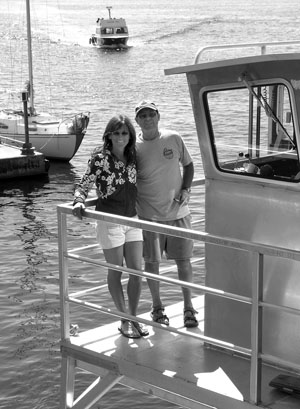 And then, there is the dedicated and slightly crazed crowd of folks who have driven cars loaded to the brim with children, dogs, bikes and cabin provisions, braved one or two ferry line-ups, to make their ultimate destination in the nick of time: the Lund Water Taxi dock. They arrive jubilant, bedraggled, anxious and ecstatic to be heading back to their beloved Savary Island. Some are heading to Hernando, and some to Cortez… but it is the lure of the luxurious white sand beaches that stretch round the entire perimeter of Savary Island that has kept Gina and Al Wood busy expanding the Lund Water Taxi empire since they purchased it in 1987.
And then, there is the dedicated and slightly crazed crowd of folks who have driven cars loaded to the brim with children, dogs, bikes and cabin provisions, braved one or two ferry line-ups, to make their ultimate destination in the nick of time: the Lund Water Taxi dock. They arrive jubilant, bedraggled, anxious and ecstatic to be heading back to their beloved Savary Island. Some are heading to Hernando, and some to Cortez… but it is the lure of the luxurious white sand beaches that stretch round the entire perimeter of Savary Island that has kept Gina and Al Wood busy expanding the Lund Water Taxi empire since they purchased it in 1987.
“When we started out we had two boats and no office,” laughs Gina, “Al and I answered the phones at home and dispatched the water taxis from the hotel dock.”
Today, the company employs up to 16 people during the busy summer months. Five certified drivers (who double as accomplished musicians, mechanics and massage therapists) operate the water taxis. Bill, Pete, Verjall, Dean and Richie load up to 12 people and all imaginable types of cabin, garden and sports equipment, plus the family pets, of course, onto water taxis. The Raggedy Anne, Channel Flyer, Jervis Mist and Comintagetcha deliver them safely to the Savary Island dock fifteen 15 later, whereupon the entire performance is repeated in reverse.
Five enterprising young adults drive the Savary Island Land Taxis—a fleet of five pickup trucks that haul people and gear and pets from the wharf to lodgings, and visa-versa. Happy to bump along over narrow forest-shadowed roads through July and August, Dru, Steve, Nick and Dani return from university and college to reside at their respective family cabins and drive Al and Gina’s land taxis.
All this is coordinated from a cheerful and bustling office overlooking the Lund Water Taxi’s private dock. Open 364 days a year, the office positively hums during the summer. A cacophony of marine and shortwave radio messages from water and land taxi drivers, plus two constantly ringing telephone lines provide the backdrop for dispatchers whose task it is to coordinate the movement of people and their gear from the water taxi dock at Lund, to their cabins and back again.
And that’s not all. In addition to delivering people to nearby islands and other coastal locations, Lund Water Taxi operates two barges, Aqua Knots III and the Giderdun II, delivering freight, heavy equipment and trucks for the scores of tradesmen and builders who work on Savary Island. The island’s summer and full time residents use the barge service to transport cars, building materials and all manner of things too large or too heavy to carry on a water taxi.
Al and Gina’s business includes a charter service to points north for a wide variety of resource-based businesses and a contract with the BC Ambulance Service to transport people with medical emergencies from Savary Island to Lund. Up until a year ago, Gina and Al refused payment for this service. “Al thought it was bad karma to charge for responding to an emergency,” explains Maggie, one of the company’s most dedicated and long-time employees.
Whether it’s moving elk to Ramsay Arm, or generators and golf carts to Savary, Al and Gina are dedicated to getting people and their stuff to where they want to go. Despite long hours and trying scenarios—two weeks worth of groceries in small white plastic bags heaped on the dock, low tides and emergency cell phone calls to plead a later water taxi after a missed ferry, the cheerful nature of all the staff, and Gina and Al themselves, indicate the rewards of a business well run have paid off.

A tale of tragedy and heroism
The wreck of the MV Gulf Stream
By Sean Percy
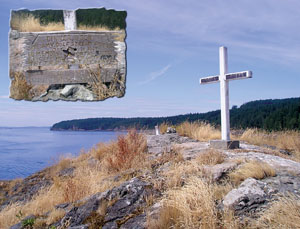 The tragedy of the wreck of the MV Gulf Stream remains one of this area’s darkest moments, but as with many tragedies, the heroism of the moment can often be overlooked.
The tragedy of the wreck of the MV Gulf Stream remains one of this area’s darkest moments, but as with many tragedies, the heroism of the moment can often be overlooked.
The 145-foot passenger liner took the lives of three children and two women when she struck Dinner Rock on her way between Westview and Lund on Saturday, October 11, 1947.
In 1948, Henry Pavid, who lost his daughter in the wreck, erected a small wooden cross on Dinner Rock. Several informal ceremonies were held over the years to remember the disaster. This month marks 10 years since a large cross was erected on the rock to permanently memorialize the disaster – and warn mariners of the dangers of the rocks and reefs of the passage. At that time, organizer Don MacGregor said the tribute was “long overdue.”
“It was a terrible night,” remembered Dave Hughes, who was on the Gulf Stream that night, but along with most of the 200 passengers, got off the boat in Westview. Just 15 passengers remained, along with 22 crew, as the Gulf Stream sliced through stormy waters on its way to Lund.
The Gulf Stream was a well-known and popular vessel, built as a 147-foot steam luxury yacht in Massachusetts in 1915. During World War II, the Canadian navy refitted her with twin diesels, reports BC maritime historian Fred Rogers, in his book Shipwrecks of British Columbia. After the war, she lost her HMCS Wolf moniker and became a passenger and freight carrier for the newly established Gulf Lines Ltd. on the Vancouver to Powell River run.
This Saturday, she was captained by Jack Craddock, not her normal skipper Captain Roy Barry. After leaving Westview, Craddock made his rounds and turned the vessel over to Second Mate Roy Ketchum. The Gulf Stream was cutting through the rainsqualls and moderate southeast seas at about 14 knots when she struck Dinner Rock. The force of the impact forced her bow out of the water and about a third of her length went up onto the steep rocks. Her stern was forced underwater and she came to rest on her port side, with passengers’ quarters flooded.
The lights went dead in just minutes.
Fortunately, skipper Bob West, of the passing fish packer, the Betty L, noticed the lights on Dinner Rock before they went out. It was an unusual sight. He was already on his way to investigate when he noticed the SOS signal. The fish boat’s spotlight lit up a terrible scene, and, at risk to themselves in the stormy seas, the crew saved many who had been unable to reach shore. Some were able to scramble over the listing deck with the help of ropes and ladders and make it to the barnacle-covered rocks, cutting their feet as they went. Lifeboats from the packer picked them up on the lee side of the rock.
Inside the Gulf Stream, the scene was even worse.
Passengers were hurled to the floor on the impact and then frigid water came rushing in. One passenger managed to break a window on the starboard side, now above their heads, and crawl out. He then reached back through to help others out. Sam Fleck credits him for saving his life, but in the confusion Fleck got separated from his wife. She drowned.
At the impact, Henry Pavid reached for his infant daughter, and missed by inches as the ship rolled.
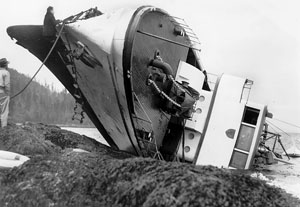 Henry and George Walkem were hauled from the main deck lounge through a window.
Henry and George Walkem were hauled from the main deck lounge through a window.
Mrs. George Walkem credited Captain Frank Petersen with saving her life, after he smashed windows with his hands to bring the 79-year-old widow to safety.
“Captain Petersen somehow got me out and that’s the only reason I’m here now,” she told the Powell River News, in an extra edition published on Sunday, October 12.
Another passenger, Norman Hope of Refuge Cove, was also a key player in the heroic rescue efforts. According to a Gulf Lines officer, “he was really pitching.”
The rescue efforts were indeed speedy. Just two hours and 20 minutes after the accident, the Betty L was at the Powell River dock with the survivors.
Seven of the 10 passengers who lived through the ordeal were hospitalized with various bruises, cuts and shock. Twenty-one crew were aboard; all survived; three were hospitalized.
On the Monday, legendary diver George Unwin, working from the salvage tug Salvor, recovered the body of Sylvia Fleck. The next day, he recovered the bodies of Kay Elliott, her adopted two-and-a-half-year-old son Lyle Hodgson and her nephew Douglas Lipsett, 3, from a cabin 30 feet under water in the stern of the ship.
“There are no more bodies in the ship,” Unwin told The News after a hazardous two-and-a-half-hour dive.
The body of tiny Jeanie Pavid, just 18 months old, was never recovered, despite the valiant efforts of rescue and recovery crews.
The Gulf Stream was said to be worth $185,000 in 1947, but salvage efforts were thought to be too expensive. Besides the damage to the hull, at least one of the engines stopped when it sucked in water, which assuredly cracked the block. Salvage was not attempted. The ship later slid off the rock, with its stern in 120 feet and the bow in 40 feet. Today, the bow, too has slid off the rock to the sandy bottom at the base of the rock, and the nose of the ship lies in about 160 feet of water. It has been picked over by divers. A brass steering wheel stand and a brass signalling device are in Fred Rogers’ collection.
Beyond the depths of most recreation divers, the wreck is occasionally visited by technical scuba divers. They find cloud sponges growing on the hull and between the beams. The superstructure of the Gulf Stream has collapsed, but the hull remains intact, providing a home for lingcod and rockfish.
A memorial marker placed by the Underwater Archaeology Society of BC recounts the disaster and urges divers to respect the underwater history.
Powell River wrestler to Olympics
Representing Australia
By Sean Percy
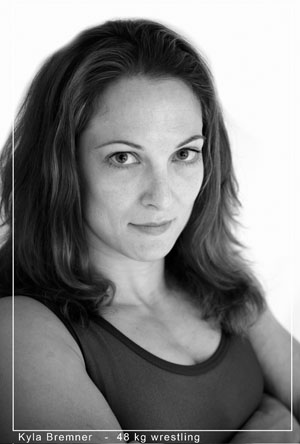 A Powell River woman will compete in the Beijing Olympics this month, but she won’t be wearing the Maple Leaf. Kyla Bremner will be the first woman to represent Australia in women’s wrestling at the Olympics. The daughter of Kay and Dennis Bremner of Wildwood graduated from Max Cameron in 1994, then went on to Simon Fraser University, where she first started wrestling. Though she had always liked sports and been athletic, at 5’2” she wasn’t a natural fit for volleyball or basketball. She competed in gymnastics in the old JP Dallos gymnasium, joined the swim club and competed in track and field and soccer with school teams.
A Powell River woman will compete in the Beijing Olympics this month, but she won’t be wearing the Maple Leaf. Kyla Bremner will be the first woman to represent Australia in women’s wrestling at the Olympics. The daughter of Kay and Dennis Bremner of Wildwood graduated from Max Cameron in 1994, then went on to Simon Fraser University, where she first started wrestling. Though she had always liked sports and been athletic, at 5’2” she wasn’t a natural fit for volleyball or basketball. She competed in gymnastics in the old JP Dallos gymnasium, joined the swim club and competed in track and field and soccer with school teams.
But when she watched a friend participate in an international wrestling tour at SFU, she found her calling, and joined SFU’s start-up women’s team.
“I loved the physicality of wrestling. It’s a sport that requires total physical fitness and total mental focus, and I liked that intensity,” said Kyla.
Because her mother is from Australia, Kyla has dual Canadian-Australian citizenship. After a couple of years of university here, she discovered that Australia offers more subsidized education, so she moved there to get her undergrad and graduate degrees. “Now she’s a doctor and hasn’t built up the huge debt that students here do,” said Dennis. So is he proud of his daughter? Let’s see, she’s a doctor and an Olympian... “Yes,” he answers. She’s now working as a medical intern at Bankstown Hospital near Sydney in New South Wales, and spent the last two years working as a locum in rural hospitals across the state. In 2000, she worked as a volunteer at the Sydney Olympics, and decided then that she would like to have the experience of competing at that level. Eight years of hard training would follow.
She does weight and strength training three time a week, cardio or circuit training three times a week and works on the mat five times a week. Qualifying and then working as a doctor while at the same time training and competing in events across the globe has demanded discipline and balance, and she has seen little of family and friends. “She spent a lot of time traveling and training in France and Germany. She has competed around the world for years,” said Dennis. But she’ll be connecting with family in Beijing. Johnson and Johnson is helping pay for the families of Australian Olympians to travel to China. So the Bremner family, including Kyla’s parents, her brother and her aunt are flying over to watch Kyla compete. Kyla is the only woman on the Australian wrestling team. She earned the spot by defeating her main New Zealand competition in a tough, close match to win the Oceania championships. Recently she won the Australian nationals and competed at the World Championships. She also won the 2008 Sassari International Tournament in Italy.
She has had to miss some competitions and training for work, and has also taken unpaid leave to go to competitions and prepare for big matches.
“But … without my job as a doctor I wouldn’t be able to fund my wrestling activities. I have to self-fund almost everything including going to Worlds and Olympic qualification events like Oceanias. Plus my hospital has been pretty supportive of me,” she said.
“I’m so pleased that women’s wrestling has become an Olympic sport in time for me to have a chance to go. I lost the national final in overtime in 2003 and the person who beat me didn’t manage to qualify for the Athens Games. That was disappointing for everyone, but happily this time around I’ve qualified and hopefully it will be a good thing for women’s wrestling in Australia,” said Kyla.
“My goal for the Olympics is to wrestle my best, and of course to go for gold. I’m definitely not a favourite to win my weight class, but I’ve come to realize that you have to enter every tournament with the goal of winning, otherwise what’s the point of being there? If you set your goals lower, as in “I’ll be happy if I score some points or win a match” then if you win a match you still haven’t won and could have done better. You have to do your best and aim for the best, which is to win the whole thing. But I also want to have fun!”
Her status as an Olympian has added to her busy schedule, as she has been interviewed and featured in Australian magazines and talk shows. She arrives in China Aug. 4. Opening exercises are on August 8. Kyla’s normal weight class would probably be the 52 kilogram class, as her normal weight is around 54 kg. But the Beijing Games mark just the second time women’s wrestling has been an Olympic sport, so there are only a couple of weight classes, and 52 kg is not one of them. She managed to cut her weight to 52 kg, no easy task for someone already in excellent shape. To compete in the 48-kilogram category, Kyla has to sweat it out prior to competition, then rapidly re-hydrate after the weigh-in to get back in fighting shape the next day. Her parents hope that she’ll some day return to Canada, but despite the country’s critical doctor shortage, Dennis says Canadian regulators don’t make it easy for foreign-trained doctors to come to Canada as specialists.
“There is a series of time-consuming and expensive exams that I have to write, then I would have a lot of trouble getting into specialty training there as well. I’d be unlikely to get into anything but GP training, which would be okay but it’s not my first choice right now. I’d like to try to get into dermatology or paediatric surgery. So for me at my stage of career it’s just not worth coming back to Canada because there are so few opportunities there for overseas-educated doctors who haven’t yet specialized,” Kyla told Powell River Living.


